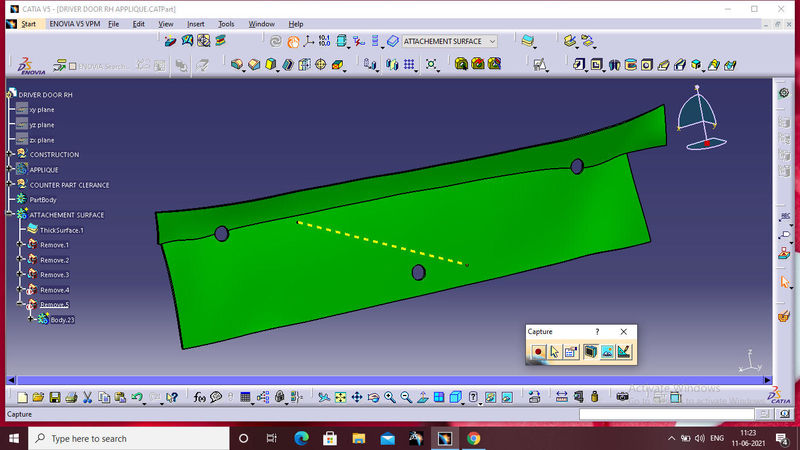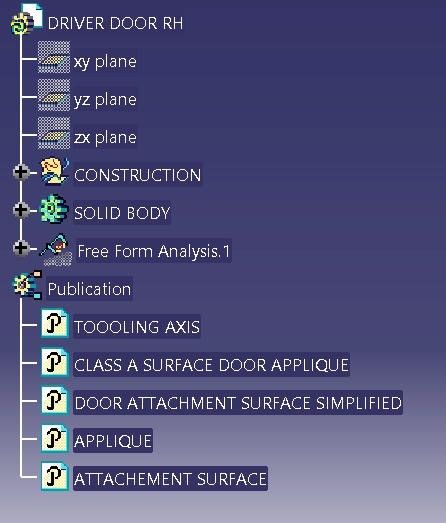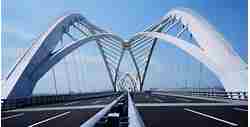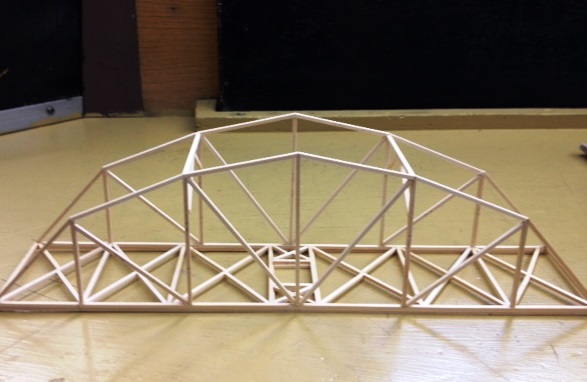Courses by Software
Courses by Semester
Courses by Domain
Tool-focused Courses
Machine learning
POPULAR COURSES
Success Stories
Week 9 - Project 1 - Door Applique Design with Engineering Features
Door Applique Design with Engineering Features OBJECTIVE: To create the Base Bracket Plastic component through the given Class-A surface. To begin with, the tooling axis for the given Class-A Surface should be created…
mariraj arumugam
updated on 11 Jun 2021
Door Applique Design with Engineering Features
OBJECTIVE:
To create the Base Bracket Plastic component through the given Class-A surface. To begin with, the tooling axis for the given Class-A Surface should be created meeting the requirements of the draft angle and at the end perform the Draft analysis on the model.
Create the Heat Stakes and the locators considering the design rules mentioned in the video for the door applique.
PROCEDURE:
CLASS A SURFACE:
Given input as an class A surface
Door applique

Attachement surface

TOOLING AXIS:
1.For tooling axis creation first extract the class A surface.
2.Then create the point on the surface of the extract surface.
3.Draw the line perpenticular to the surface,That is the tooling axis of the given class A surface.

CLASS B SURFACE:
1.To create the class B surface,First extract the class A surface and untrim the extracted surface.
2.Then extrapolate the untrim surface to completely intersect with each other.
3.Then Trim the untrim surface with each other and offset the trim surface to 2.5mm.That is the thickness of the component.
4.finally give the radius of 12.5mm,this is the class B surface.


CLASS C SURFACE:
1.For class C surface,First extract the outer boundary of the class A surface.
2.Next step is to swep the extracted boundary reference with the tooling axis,This is the required class c surface.


INITIAL TRIMS:
1.First step is to join the class A surface with class C surface.
2.Than trim the class b surface with the join surface,this is the required trim surface.

SOLID APPLIQUE BODY:
1.To make the surface body in to solid body open the part work bench.
2.And open the close body command and select the surface to make solid.

LOCATORS:
1.For the locator first extract the class A surface and create the point on the extracted surface,then insert the plane.
2.Then create the sketch on the inserted plane,Draw the loctaors line from center 15mm for both sides.
3.Next step is to pad it the sketch and give the thickness and height value.
4.Finally add the draft and fillet values of the locator.

Then copy the locator and paste it again,and translate to the required destination.

Then create an another sketch for two way locator and then pad it ,and give the draft angle and radius. value.Finally unitrim with applique and locators.
To follow the desgin rule for rib,it is same as the locator also.

HEAT STAKES:
Heat staking technology is quite simple in concept. Whenever two or more components need to be attached to one another, and at least one is made of a thermoplastic, a combination of heat and pressure can be used to reform the plastic to the many shapes or profiles to retain or join the parts together.
The main advantage to heat staking, when compared to fastener-based technologies, is that manufacturers can perform all heat staking in one machine cycle and motion versus individual motions required for each fastener. A secondary benefit is that the manufacturers do not need to change the base material – it can remain “AS-IS” while the plastic is heat staked to conform to its final dimensions.
1.For heat stakes to extract the outer boundary of aplique and craete the required number of points on the extracted boundary.
2.Then offset the boundary of 15mm by using parallel curve option.
3.Then draw a sketch on the plane which is used for craeting locators,draw two circle dia5 @ dia7.
4.Pad it the circle to the required height,then translate the heat stakes to the required number of times.

ATTACHEMENT SURFACE:
1.first step is to thicken the given class A attachement surface in to 2.5mm.

2.For creating the position for locator draw the sketch and pad it the the sketch and give the require amomnt of relif and remove the pad from the attachement surface.
Position for locator

3.Follow the same way for the heat stakes position also.draw the clearance circle and pad it,then remove the pad from the attachement surface.
4.Follow the same procedure for all 12 heat stakes.


VIEWS:
FRONT VIEW:

SIDE VIEW:

TOP VIEW:

ISOMETRIC VIEW:

DRAFT ANALYSIS:



TREE STRUCTURE:



RESULT:
The creation of the Base Bracket Plastic component through the given Class-A surface. And the tooling axis for the given Class-A Surface should be created meeting the requirements of the draft angle and at the end performed the Draft analysis on the model.
Created the Heat Stakes and the locators considering the design rules mentioned in the video for the door applique are sucessfully done by using catia software.
Leave a comment
Thanks for choosing to leave a comment. Please keep in mind that all the comments are moderated as per our comment policy, and your email will not be published for privacy reasons. Please leave a personal & meaningful conversation.
Other comments...
Be the first to add a comment
Read more Projects by mariraj arumugam (25)
Week 11 - Final project
FINAL PROJECT DOOR TRIM PANEL: OBJECTIVE: TO CREATE Create thickened part using master section for reference Create the mounting features as per design guidelines in the industry and with master sections Apply material details : Draft analysis & Tooling analysis Creation of parting lines and check tooling feasibility.…
30 Sep 2021 06:58 PM IST
Week 11- Assembly Workbench
DESIGN AND ASSEMBLY OF QUICK RETURN MECHANISM: QUICK RETURN MECHANISM A quick return mechanism is an apparatus to produce a reciprocating motion in which the time taken for travel in return stroke is less than in the forward stroke. It is driven by a circular motion source (typically a motor of some sort) and uses a…
09 Aug 2021 05:39 PM IST
Week 9 - Project - Master Section Development
Design B-Pillar Through Master Section Development AIM: DESIGN AND DEVELOPMENT OF THE B-PILLAR THROUGH MASTER SECTION DEVELOPMENT (INTERIOR TRIM). B-PILLAR: B-Pillar is the pillar on both sides just behind the driver's seat. B Pillar is the most complex component/structure of the vehicle body. This is because the front…
25 Jul 2021 05:01 PM IST
Week 9 - Project 1 - Door Applique Design with Engineering Features
Door Applique Design with Engineering Features OBJECTIVE: To create the Base Bracket Plastic component through the given Class-A surface. To begin with, the tooling axis for the given Class-A Surface should be created…
11 Jun 2021 06:36 AM IST
Related Courses






0 Hours of Content

Skill-Lync offers industry relevant advanced engineering courses for engineering students by partnering with industry experts.
Our Company
4th Floor, BLOCK-B, Velachery - Tambaram Main Rd, Ram Nagar South, Madipakkam, Chennai, Tamil Nadu 600042.
Top Individual Courses
Top PG Programs
Skill-Lync Plus
Trending Blogs
© 2025 Skill-Lync Inc. All Rights Reserved.








